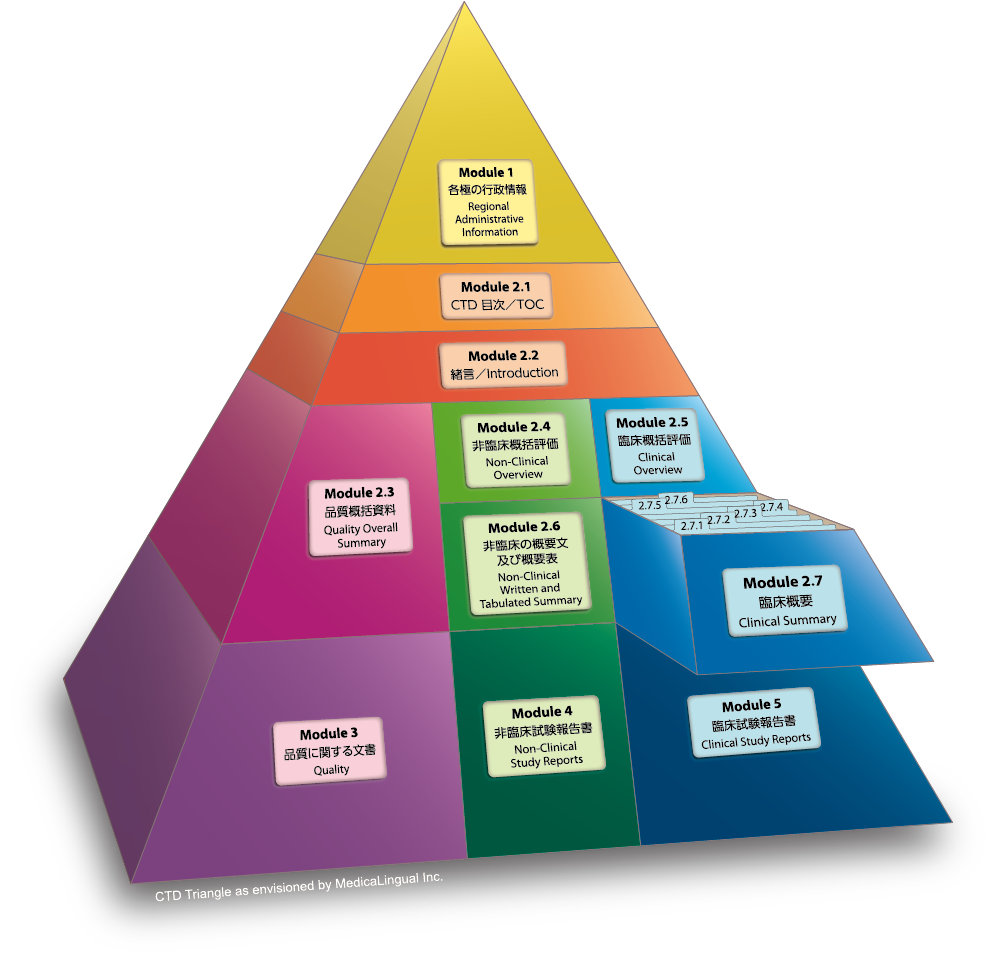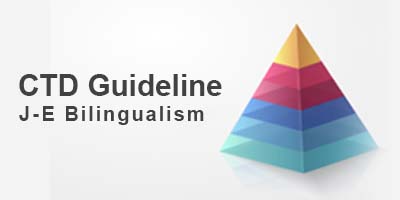
薬生薬審発0202第1号(平成29年2月2日)
ICH HARMONISED GUIDELINE- M4E(R2) – Dated 15 June 2016
Module 2.7 臨床概要
2.7.4 臨床的安全性の概要
2.7.4.1 医薬品への曝露
2.7.4.1.1 総括的安全性評価計画及び安全性試験の記述
本項では、安全性に関する評価計画の全体を概括すること。その際、非臨床データ、同じ薬効分類の薬剤に共通する作用、そして臨床では、安全性データの元となった資料(比較対照試験、オープン試験等)について特に配慮したり観察した事柄に言及すること。記載は、一般的には、一覧表形式にて安全性データの元となった全ての臨床試験を適切にグループ化し、まとめること(第2.7.4項付録を参照)。有効性と安全性を共に評価した試験や安全性情報を得た非対照試験のみでなく、安全性上の特別な問題点を検討した試験も列記すること。例として、二つの異なる治療法を用いて特定の有害事象の発現率を比較検討した試験や、特別な人口統計学的特性について検討した安全性試験、離脱症状や反跳現象を検討した試験、その他、特定の有害事象(例:鎮静、性的機能、運転に対する影響、同一薬効群の薬剤で一般的に認められる有害事象がないこと)を評価した試験等が挙げられる。当該申請にて承認を求めていない適応症についての試験や進行中の試験も、安全性の解析に有用であるならば、本項の表に含めること。
Module 2.7 CLINICAL SUMMARY
2.7.4 Summary of Clinical Safety
2.7.4.1 Exposure to the Drug
2.7.4.1.1 Overall Safety Evaluation Plan and Narratives of Safety Studies
The overall safety evaluation plan should be described briefly, including special considerations and observations concerning the nonclinical data, any relevant pharmacological class effects, and the sources of the safety data (controlled trials, open studies, etc). A tabular listing of all clinical studies that provided safety data, grouped appropriately, should generally be provided (see the section 2.7.4.7 Appendix). In addition to studies that evaluated efficacy and safety, and uncontrolled studies that generate safety information, this section includes studies that consider special safety issues. Examples would include studies to compare particular adverse event rates for two therapies, to assess safety in particular demographic subsets, to evaluate withdrawal or rebound phenomena, or to evaluate particular adverse events (e.g., sedation, sexual function, effects on driving, absence of a class adverse effect). Studies in indications for which approval is not being sought in the current application and ongoing studies would also be included here if they contribute to the safety analysis.
本項では、これらの試験について文章で説明すること。ただし、有効性と安全性データの両方を含む試験の説明は第2.7.3.2項に記載し、本項ではそれを参照すること。説明の詳しさは、審査担当者が被験薬又は対照薬への曝露状況を理解でき、またどのように安全性データを収集したかが理解できるようなものであること(例:収集方法及び個々の試験における被験者観察の範囲)。試験一つ一つでなく、グループ化して解析した場合、その旨を記載し、一つの説明にまとめてもよい。
Narrative descriptions of these studies should be provided here, except that narrative descriptions for studies that contributed both efficacy and safety data should be included in Section 2.7.3.2 and cross-referenced here. The narratives should provide enough detail to allow the reviewer to understand the exposure of study subjects to the test drug or control agent, and how safety data were collected (including the methods used and the extent of safety monitoring of the subjects enrolled in the individual studies). If some studies are not analysed separately but are grouped for safety analysis, that should be noted, and a single narrative description can be provided.
2.7.4.1.2 全般的な曝露状況
全ての臨床開発の相における治験薬への曝露状況を表形式(第2.7.4項付録中の例を参照)にまとめ、適切な説明をつけて概括すること。表には、異なるタイプの試験、異なる投与量、投与経路、投与期間別に曝露された被験者数を示すこと。もしも、投与量、曝露期間の種類が多い場合、当該医薬品に適切と思われる方法でグループ化してよい。例えば、各投与量、投与量の範囲、投与期間ごとに、1日以下、2日から1週、1週から1ヵ月、1ヵ月から6ヵ月、6ヵ月から1年、1年超(ICH E3)といった曝露期間別に被験者数を表示することができる。申請適用におけるその医薬品の安全性評価に特別な意味を持つと思われる診断別部分集団や特定の併用療法を受けた患者群を明確にすることが重要となる申請もある。
2.7.4.1.2 Overall Extent of Exposure
A table (see example provided in the section 2.7.4.7 Appendix) and appropriate text should be generated to summarise the overall extent of drug exposure from all phases of the clinical study development programme. The table should indicate the numbers of subjects exposed in studies of different types and at various doses, routes, and durations. If a large number of different doses and/or durations of exposure were used, these can be grouped in a manner appropriate for the drug. Thus, for any dose or range of doses, duration of exposure can be summarised by the number of subjects exposed for specific periods of time, such as 1 day or less, 2 days to 1 week, 1 week to 1 month, 1 month to 6 months, 6 months to 1 year, more than 1 year (ICH E3). In some applications it may be important to identify diagnostic subgroups and/or groups receiving specific concomitant therapies deemed particularly relevant to safety assessment in the intended use.
この表に記載される投与量は、投与された最大投与量、最も長期間投与された用量、平均1日用量等が考えられる。累積投与量が適切である場合もある。表示法としては、必要に応じ、実際に投与された1日用量又はmg/kgあるいはmg/m2単位とする。有害事象や臨床検査値の変化との相関性を検討するため薬物濃度(例:有害事象発現時の濃度、最大血漿中濃度、AUC)も、もしデータがあれば、有用である。
The dose levels used for each subject in this presentation could be the maximum dose received by that subject, the dose with longest exposure, and/or the mean daily dose, as appropriate. In some cases, cumulative dose may be pertinent. Dosage may be given as the actual daily dose or on a mg/kg or mg/m2 basis, as appropriate. If available, drug concentration data (e.g., concentration at the time of an adverse event, maximum plasma concentration, area under curve) may be helpful in individual subjects for correlation with adverse events or changes in laboratory variables.
安全性解析には、治験に組み入れられ、少なくとも1回治験薬の投与を受けた全ての被験者を含めるものと想定している。そうでない場合には、その旨説明すること。
It is assumed that all subjects who were enrolled and received at least one dose of the treatment are included in the safety analysis; if that is not so, an explanation should be provided.
2.7.4.1.3 治験対象集団の人口統計学的特性及びその他の特性
要約表を作成し、開発期間中、治験薬に曝露された集団の人口統計学的特性(表2.7.4.2)について概観すること。年齢幅を決める時は、ICH E7 (特別な患者集団における試験:高齢者) 及びICH E11 (小児集団における医薬品の臨床開発について)での議論を考慮すること。もし、比較対照試験における人口統計学的特性別グループでの曝露が全体の曝露との比較において異なる場合、まとめの表は別にする方が便利なこともある。
2.7.4.1.3 Demographic and Other Characteristics of Study Population
A summary table should provide the reader with an overview of the demographic characteristics (Table 2.7.4.2) of the population that was exposed to the therapeutic agent during its development. Choice of age ranges used should take into account considerations discussed in ICH E7 [Studies in Support of Special Populations: Geriatrics] and ICH E11 [Clinical Investigation of Medicinal Products in the Paediatric Population]. If the relative exposure of demographic groups in the controlled trials differed from overall exposure, it may be useful to provide separate tables.
さらに、一つ以上の表を用い、試験集団全体の特性及び特殊な特性を有する被験者数を示すこと。特殊な特性には次のものが含まれる。
- 疾患の重症度
- 入院
- 腎機能障害
- 合併症
- 特定の医薬品の併用
- 治験実施地域
In addition, one or more tables should show the relevant characteristics of the study population, and the numbers of subjects with special characteristics. Such characteristics could include:
- Severity of disease
- Hospitalisation
- Impaired renal function
- Concomitant illnesses
- Concomitant use of particular medications
- Geographical location
これらの特性が比較対照試験と全体のデータベースの間で異なる分布を示す場合、一般的に両グループを別の表で示すとよい。
被験薬とプラセボ、対照薬との間で人口統計学的特性上の不均衡があれば表に説明をつけること。特に、その不均衡が安全性の評価結果に違いをもたらす可能性がある場合には、説明をつけること。
また、特定の患者(合併症、疾患の重症度、併用医薬品)を除外した場合、その事実を記載すること。
人口統計学的特性は、適応症ごとに一覧表としてまとめること。ただし、適応症が相互に密接に関連している場合、被験者特性からみたリスクが同じと考えられるならば、一緒に扱ってよい。
If these characteristics are distributed differently in controlled trials versus the overall database, it will generally be useful to present tables on both groupings.
The text accompanying the table(s) should mention any imbalance(s) between the drug and placebo and/or comparator regarding any of the above demographic characteristics, particularly if they could lead to differences in safety outcomes.
If certain subjects were excluded from studies (concomitant illness, severity of illness, concomitant medications), this fact should be noted.
Separate demographic tables should be provided for every indication, although closely related indications can be considered together, if study subject characteristics are such that risks are believed to be the same.










